As robotics, automation, and electrification sweep across warehouse and fleet operations, a new constraint is emerging, electricity availability. In key fulfillment corridors across the U.S. and Europe, demand for power is outpacing what local grids can deliver, delaying facility upgrades, straining peak capacity, and introducing a hidden variable into logistics network planning: volts per square foot.
From e-trucks and fast chargers to high-density AS/RS systems and cold-chain storage, the energy intensity of logistics operations has surged. Yet grid infrastructure, particularly in suburban or industrial edge zones, has remained static, triggering power rationing, permitting delays, and multi-year wait times for utility-scale upgrades. Companies now face a new planning challenge: operational readiness is increasingly gated by electrical headroom.
From Footprint to Powerprint
The traditional warehouse site selection model prioritized real estate, labor, and transit access. But companies deploying high-automation or EV-heavy operations are learning that grid capacity can override all other factors.
In high-growth regions like Southern California, electrification efforts are colliding with multi-year interconnection delays. Some electric truck depot projects in the state have faced wait times of up to five years to secure sufficient power from local utilities, prompting operators to explore on-site microgrids and battery backups to bridge the gap.
Similar pressures are playing out across Europe. In countries like the UK and the Netherlands, industrial and renewable energy projects are being told to wait up to a decade for grid connection approval, due to overloaded utility queues and limited substation capacity.
Even in retrofit scenarios, such as adding EV chargers or high-density automation, developers are encountering prolonged permitting cycles. These upgrades often trigger new grid impact assessments that can stretch for multiple quarters before receiving final signoff.
Amazon has reportedly begun integrating utility data into its site selection algorithms, and Walmart is piloting mobile battery stations at power-constrained nodes. In the UK, logistics developers are offering shared power banks across adjacent tenants to smooth peak draw and qualify for grid connections.
The Power-Constrained Logistics Stack
Grid Availability Mapping: Operators are now integrating regional utility load maps into facility planning. By pre-screening sites based on kilowatt-hour availability and upgrade lead times, companies can avoid locations where electrification ambitions will be throttled by grid headroom.
EV Charging Allocation: As fleet electrification scales, distribution centers are prioritizing which vehicles charge when. Load-balancing software now staggers charging based on route urgency, power cost, and facility usage, preventing grid penalties or on-site blowouts.
Permitting and Utility Coordination: Facilities are assigning dedicated teams to manage electrical permitting. Some are negotiating directly with utilities for dedicated substations or grid priority, while others co-invest in infrastructure upgrades to accelerate timelines.
Load-Shedding Contingencies: To maintain uptime, operators are deploying backup generators, on-site battery storage, and solar arrays not just for cost, but for continuity. In some locations, demand response programs are also monetized—trading scheduled power reductions for grid credits.
Kilowatt-Aware Automation Deployment: Warehouse systems integrators are beginning to model robot fleet load profiles alongside traditional throughput KPIs. Automation rollouts now include electrical feasibility layers, ensuring that picker bots, shuttles, and conveyors don’t exceed the building’s power envelope during peak shifts.
When Logistics Meets Load Planning
What was once a facilities or sustainability concern is now a frontline logistics issue. As grid constraints become operational chokepoints, companies are rethinking fulfillment resilience through an electrical lens. The next phase of capacity planning goes beyond square footage and SKU count. It means modeling electrons as aggressively as pallets, and ensuring that digital ambition isn’t short-circuited by analog infrastructure.



